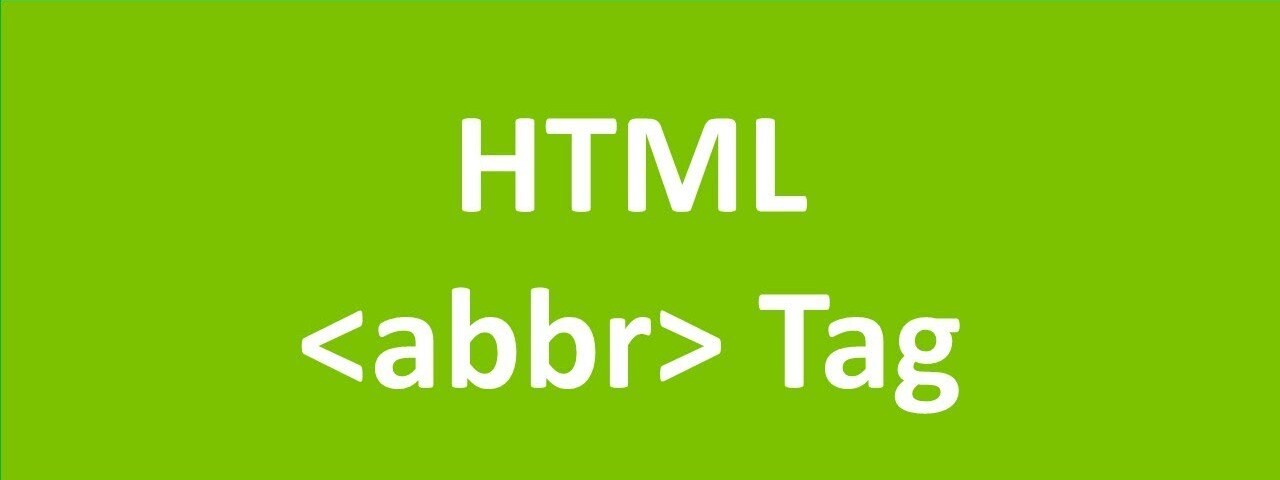What is the Purpose of the <abbr> Tag in HTML? Best Practices for Using the <abbr> Tag in Your HTML Code
{tocify} $title={Table of Contents}
HTML, or Hypertext Markup Language, is a markup language used to create web pages and applications. It consists of various tags that define the structure and content of the web page. One of the tags in HTML is the <abbr> tag.
In this blog post, we will explore the <abbr> tag's definition, usage, syntax, attributes, examples, and best practices.
What is the <abbr> tag?
The <abbr> tag stands for “abbreviation.” It is used to mark up an abbreviation or acronym on a web page or document.
The <abbr> tag is a semantic tag, which means it provides additional information about the content it wraps.
The <abbr> tag is usually used in conjunction with the title attribute to provide a full explanation or definition of the abbreviation or acronym.
Usage of the <abbr> tag
The <abbr> tag is used to mark up abbreviations or acronyms in a web page or document. It provides a way for authors to indicate to users the meaning of an abbreviation or acronym.
The <abbr> tag can also be used to indicate a shortened version of a term that is frequently used in a document.
Syntax of the <abbr> tag
The syntax of the <abbr> tag is straightforward. Here is an example of how to use the <abbr> tag:
<abbr title="World Health Organization">WHO</abbr>{codeBox}
In this example, “WHO” is the abbreviation, and “World Health Organization” is the full explanation or definition.
The title attribute is used to provide the full explanation or definition of the abbreviation.
Attributes of the <abbr> tag
The <abbr> tag supports the following attributes:
- title: This attribute specifies the full explanation or definition of the abbreviation or acronym. It is a required attribute.
- class: This attribute specifies one or more class names for the element. It is used to apply styles to the element.
- id: This attribute specifies a unique identifier for the element. It is used to target the element with CSS or JavaScript.
Examples of the <abbr> tag
Here are some examples of how the <abbr> tag can be used in a web page:
<p>The <abbr title="HyperText Markup Language">HTML</abbr> is the standard markup language for creating web pages.</p>{codeBox}
<p>The <abbr title="World Wide Web Consortium">W3C</abbr> is an international community that develops web standards.</p>{codeBox}
In these examples, the <abbr> tag is used to mark up the abbreviations "HTML" and "W3C."
The title attribute is used to provide the full explanation or definition of the abbreviations.
Calculation:
The <abbr> tag in HTML is a simple yet effective way to mark up abbreviations and acronyms on a web page. Using the <abbr> tag and the title attribute, you can provide additional information to your users about the meaning of these abbreviations and acronyms.
It is essential to use this tag sparingly and provide full explanations for each abbreviation to ensure that your users have a clear understanding of the content on your web page.
Following these best practices can make your web pages more accessible and user-friendly.
Best practices for using the “<abbr>” tag
Here are some best practices for using the “<abbr>” tag in your web pages:
- Use the <abbr> tag to mark up abbreviations and acronyms on your web page.
- Always provide a full explanation or definition of the abbreviation or acronym using the title attribute.
- Use the <abbr> tag sparingly. Don't mark up every abbreviation or acronym on your web page; only the ones that are commonly used or may be unfamiliar to your audience.
- Don't use the <abbr> tag to mark up initialisms. Use the <acronym> tag instead.
Conclusion:
Friends, according to my expertise, I have written complete information to help you with “HTML <abbr> Tag” If this post is favourable for you or not, please tell me by commenting.
If you liked this post, do not forget to share it with your friends so they can get information about it.
You can ask us through comments if you still have questions or doubts, I will answer all your questions, and you can contact us for more information.
Please tell us through the comment section if you think we miss anything.

